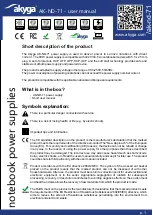
Special Welding
Techniques
Section 4
16
PROCESS DISCUSSIONS
This section is provided to give a brief overview of different stud welding processes. If you have additional questions, consult
your distributor for additional information or refer to the “Recommended Practices for Stud Welding”; ANSI/AWS C5.4,
American Welding Society, Inc.
General Process Discussion
The arc stud welding process involves the same basic principles as any other arc welding process. Application of the process
consists of two steps:
(1) Weld heat is developed with an arc between the stud (electrode) and the plate (work).
(2) The two pieces are brought into contact when the proper temperature is reached.
The time required to complete a weld varies with the cross-sectional area of the stud. For example, weld time typically would
be about 0.13 seconds for a 10 gage (0.134 in.[2.6 mm]) stud, and 0.92 seconds for a 7/8 in. (22 mm) diameter stud.
There are 4 basic Arc Stud Welding Processes
1.
Standard Drawn Arc Stud Welding (DASW). This Process uses a flux load embedded into the weld end and a
sacrificial ceramic ferrule for shielding. Because of the autofeed feature, QuikLinx foregoes the ceramic ferrule.
2. Gas Arc Stud Welding (GASW). This process uses no flux load and no ceramic ferrule. It does rely on shielding gas to
protect the weld zone.
3. Short Cycle Stud Welding (SCSW). This process uses no flux, ferrule or shielding gas. Welds are achieved with high
currents and short weld times. Welds of this nature are subject to porosity.
4. Gas Arc Short Cycle Stud Welding (GASCSW). This weld uses high current and short weld times similar to SCSW, but
adds shielding gas to prevent porosity.
Standard Drawn Arc Stud Welding (DASW) with flux load
The stud is loaded into the stud weld tool or weld head chucking mechanism, the ferrule (also known as an arc shield) is placed
into the ferrule grip over the end of the stud, and the weld tool is properly positioned for welding, The trigger is then pressed,
starting the automatic welding cycle. Note: The QuikLinx clip is unique in that it does not require a ceramic ferrule.
A lift mechanism within the body of the weld tool is energized. This lifts the stud off the work and, at the same time, creates
an arc. The end of the stud and part of the work piece are melted by the arc. When the preset arc period is completed, the
welding current is automatically shut off and the lift mechanism is de-energized by the control unit. The weld tool plunges
the stud into the molten pool on the work to complete the weld. The weld tool is then lifted from the stud and the ferrule is
broken off.
The Drawn Arc Stud Welding (DASW) process is the most robust stud welding process. It can weld effectively and reliably
under a broad range of conditions. The flux/ferrule combination also provides the greatest weld penetration into the base
material. Of the available arc processes, this should be the designer’s first choice. The other processes are typically selected
as a trade off for some factor.
Gas Arc Stud Welding (GASW) (uses shielding gas)
This process is similar to the DASW with a few exceptions. The stud is loaded into the chuck. There is a spark
shield used for gas delivery in place of the ferrule grip and the ferrule. The weld tool is properly positioned. The trigger is
pulled and gas pre-flow begins. When the pre-flow time has elapsed the automatic weld cycle begins and follows the same
Summary of Contents for QuikLinx 10700
Page 9: ...Safety Precautions Section 1 8 Symbols and Definitions ...
Page 28: ...Section 2 Section 7 Exploded Diagram 27 Figure 21 1 9 8 12 13 4 5 7 6 10 11 3 2 ...
Page 30: ...Section 2 Section 7 Exploded Diagram 29 Figure 22 5 1 2 3 4 ...
Page 32: ...Please visit us on the web www imageindustries com twitter studwelding ...
















































